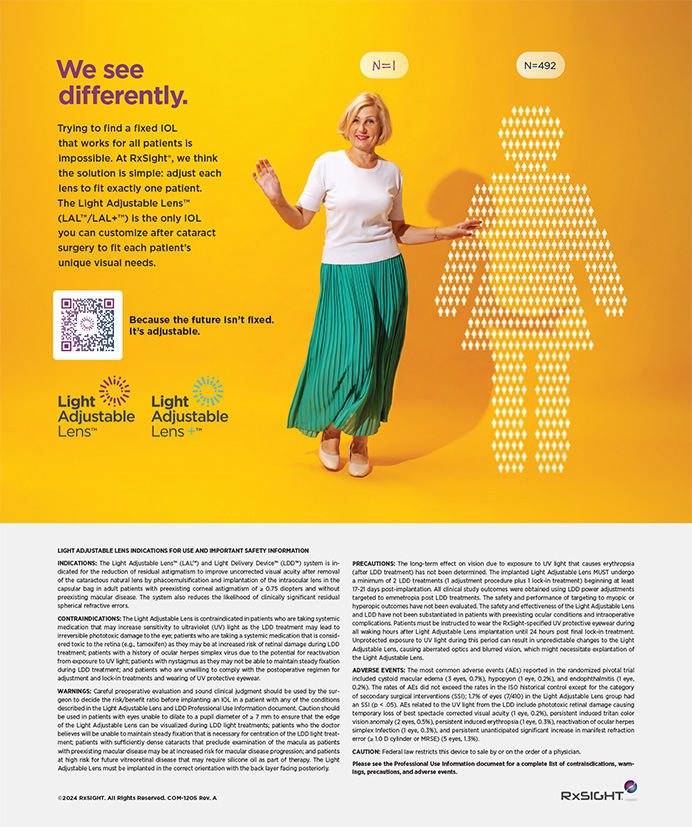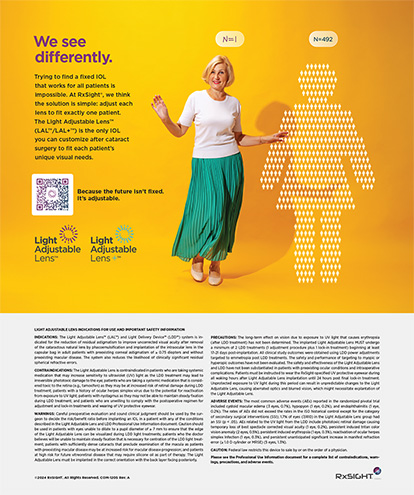Cataract Surgery | Jun 2005
Phacoemulsification of the Mature Nucleus
Advice on managing the brown or black cataract.
Priscilla Perry Arnold, MD; Lisa Brothers Arbisser, MD; John D. Hunkeler, MD; and D. Michael Colvard, MD
INTRODUCTION
Whether brown or black, the nuclear mature lens often presents a challenge to the cataract surgeon. In this article, experts share their pearls for managing these difficult cases.
THE BROWN CATARACT
Priscilla Perry Arnold, MD
One of the most important aspects of any successful cataract surgery, including dealing with a hard (dense) nucleus, is surgical planning. At the time of the preoperative examination, your attention to detail sets the stage for the ultimate outcome.
In addition to the dense nuclear sclerosis, note other complicating factors, including endothelial dystrophy, a shallow anterior chamber, a pre-existing bleb, the presence of exfoliation, or evidence of previous trauma or inflammation. Any of these conditions, especially in combination with a hard nucleus, may necessitate an alteration of your routine procedure.
Consider whether circumstances indicate that peribulbar anesthesia would be a more appropriate choice than topical anesthesia. Achieve maximal pupillary dilation for surgery by whatever technique is necessary. Ordinarily, pharmacologic, viscoelastic, or stretching maneuvers are adequate. In rare circumstances, hooks or expander rings may be required. Be prepared for this instance.
Select the viscoelastic with properties best suited to the case and any special challenges—whether for protecting the cornea, maintaining space, or tamponading the vitreous. Tailor your choice to the challenge.
Plan to use the phaco technique most effective for the circumstances and your own experience (whether a dividing or chopping process). Modulate the machine's parameters to minimize intraocular energy. Also, select the IOL material and design based on the situation anticipated but predetermine a back-up lens.
At the time of surgery, proceed deliberately and methodically. Speed is the enemy in any difficult situation. Adequate visualization coupled with safe and effective surgical manipulation will result in the best outcome for the patient.
Lisa Brothers Arbisser, MD
When operating on an eye with a hard nucleus, retract the sleeve of the phaco tip as far as possible without allowing irrigation into the incision's tunnel in order to avoid collapsing the chamber. The retracted sleeve will expose approximately 2mm of the phaco needle to permit its adequate entry into the nucleus. This technique allows a vertical chop without sculpting and creates a fault line in the nucleus that results in two hemispheres. The exposed phaco needle functions as a “dipstick,” which measures how deeply it penetrates the lenticular material. Knowing that the average lens is 4.60mm thick for a 60-year-old gives assurance of the needle's safe depth when plunged to the level of the sleeve.
THE BLACK CATARACT
John D. Hunkeler, MD
When faced with a dense nucleus, I use the stop-and-chop nucleofractis technique combined with a technique pioneered by Howard Gimbel, MD, of Loma Linda, California, called posterior pole exploration. The term describes a very short ultrasound phacoemulsification with a compact linear groove aiming toward the posterior pole of the lens. The narrow groove allows efficient emulsification to set the stage for a cleavage plane that will extend through all the layers of the nucleus.
I use the following steps with a dense nucleus. After hydrodissection (without hydrodelineation), I loosen the nucleus and compact cortex from the capsular bag, as apparent by rotation of the material within the capsular bag. With ultrasound, I complete a short, central but deep groove. The ultrasound and dissection point toward the posterior pole of the lens through the deeper nuclear layers and compact cortex. I pay less attention to the lateral, peripheral nuclear layers and epinucleus at this time. My arrival at the posterior pole of the nucleus is indicated by a dramatic improvement in the red reflex, in addition to my judgment that the clarity is adequate to achieve nuclear fracture through the posterior plate of the nucleus and the lateral peripheral layers in that meridian.
Using the nucleus rotator and the exposed tip of the phaco needle, I create two new heminuclear fragments. The remaining heminuclear fragment can be dealt with using the same instrument for horizontal chopping or a more conventional chopping instrument for vertical chopping. Regardless, four to six fragments are created for emulsification in the safe zone in the center of the pupil. As a result, the hybrid procedure of divide and conquer and phaco chop can effectively remove the dense nucleus prior to cortical cleanup.
Occasionally, the leather-like posterior aspect of the peripheral nuclear fibers is not cleaved. In this situation, further ultrasound dissection to enhance the red reflex and thin the posterior plate will allow nuclear cracking through this posterior plate. With a dense nucleus, there is often a need to grasp and regrasp nuclear fragments. In an additional maneuver, the bevel of the phaco tip can be pointed either laterally or posteriorly to minimize cavitational energy directed toward the endothelium. I will add an ophthalmic viscosurgical device (OVD) as needed to protect the endothelium and enhance safety.
To optimize the surgical outcome, microburst phacoemulsification and a focus on grasping and chopping to create smaller fragments will further reduce the total amount of energy, thus promoting the safe and effective removal of dense nuclear material.
The technique described requires a precise, intact capsulorhexis. With dense nuclei, a larger capsulorhexis is preferred. Improved visualization of the capsule is key and may be achieved through staining with either trypan blue or indocyanine green dye. The need for capsular staining is obvious when the red reflex is absent.
D. Michael Colvard, MD
My approach is informed by two observations. The first is that the truly rock-hard nucleus is almost invariably associated with a tissue-thin capsule and very fragile zonules. The second is that, unlike most contemporary cases, for which the refractive outcome defines success, the elderly patient with a ruby red cataract is invariably happy just to see again. This patient is unlikely to be upset by 0.50 to 1.00D of postoperative cylinder.
Occasionally, I am pleasantly surprised that the nucleus is not as dense as it appeared upon slit-lamp examination and the phaco procedure can be completed safely. I use trypan blue to stain the capsule and a dispersive OVD to protect the endothelium. I divide the nucleus into quadrants with deep grooves and then chop the quadrants. If the first four or five passes with the phaco device do not seem to make a dent in the nucleus, however, I do not hesitate to convert to a standard extracapsular procedure.
The one pearl I have for surgeons who do not perform extracapsular cataract extractions very often is to use the OVD to lift the huge nucleus out of the fragile capsule without placing stress on the zonular system. I make several radial cuts in the capsulorhexis' margin and enlarge the incision. If I have made any kind of notch in the anterior surface of the nucleus, I place my chopper through the sideport, direct it nose down in the notch, and slide the nucleus inferiorly toward the patient's feet. Simultaneously, I use the OVD cannula to press gently on the posterior lip of the primary incision. The chamber partially shallows, and the proximal edge of the nucleus rises above the iris margin.
I then engage the nucleus just under its equator with the OVD cannula and inject viscoelastic beneath the lens. As I gently fill the capsular bag, I lift and rotate the large nucleus into the anterior chamber. The nucleus can then be spun out of the eye with a Sinskey hook without placing any stress on the capsule or the zonules whatsoever.
Section editor William J. Fishkind, MD, FACS, is Codirector of the Fishkind and Bakewell Eye Care and Surgery Center in Tucson, Arizona, and Clinical Professor of Ophthalmology at the University of Utah in Salt Lake City. Dr. Fishkind may be reached at (520) 293-6740; wfishkind@earthlink.net.
Lisa Brothers Arbisser, MD, is in private practice in Davenport, Iowa. Dr. Arbisser may be reached at (563) 323-8888; drlisa@arbisser.com.
Priscilla Perry Arnold, MD, is the immediate past president of the ASCRS and is in private practice at Arnold Vision in Springfield, Missouri.
Dr. Arnold may be reached at (417) 890-8877; ppa@arnoldvision.com.
D. Michael Colvard, MD, is Assistant Clinical Professor at University of Southern California School of Medicine in Los Angeles. Dr. Colvard may be reached at (818) 906-2929; eyecolvard@earthlink.net.
John D. Hunkeler, MD, is Clinical Professor and Former Chair of the Department of Ophthalmology, University of Kansas School of Medicine, Kansas City, and Founder of Hunkeler Eye Institute, PA, in Kansas City, Missouri. Dr. Hunkeler may be reached at (816) 931-4733; jhunkeler@hunkeler.com.


